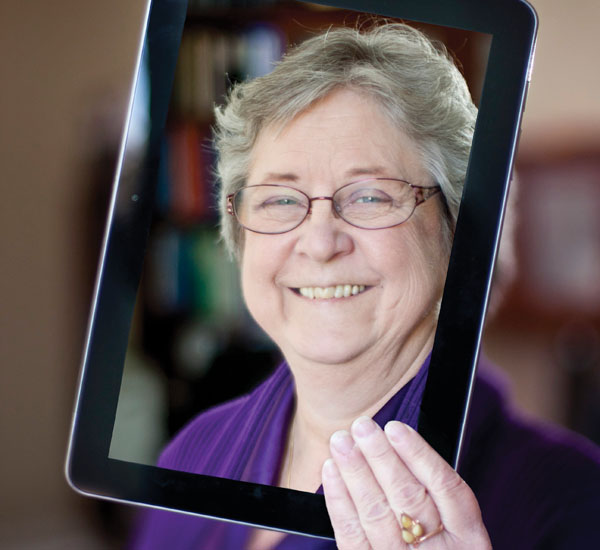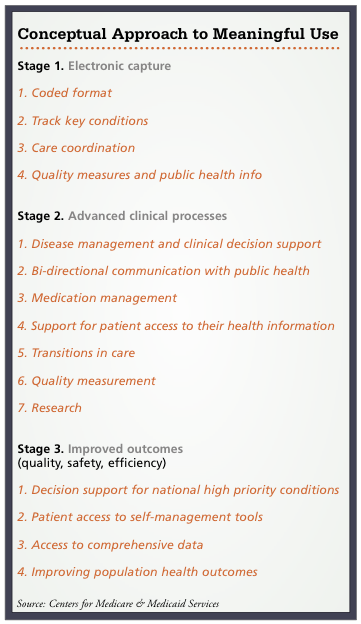
What does the term “nursing informatics” mean?
Nursing informatics is a specialty recognized by the American Nurses’ Association. Nursing informatics transforms electronic information into knowledge and eventually knowledge into wisdom needed to improve outcomes. Nursing outcomes can only be improved if you can apply wisdom across any number of areas, and a person needs advanced knowledge to interact with a spectrum of professionals in this way. Nursing informatics is about getting the right knowledge and the right information to the right person at the right time to make the right decisions for patients and families.
Can you provide a real-life example?
One great example is work done at Vanderbilt University Medical Center regarding Ventilator-Acquired Pneumonia (VAP), where there are many regular procedures that need to be done. Vanderbilt created a dashboard – one computer screen with all the most important data put into visual form. So, if one of the procedures that a patient needs is completed, it’s green on the dashboard. If it’s coming due, it’s yellow, and if it’s past due, it’s red. This new system reduced the number of patients acquiring VAP across six intensive care units by 41 percent during a 10-month period and saved between $1.9 million and $3.5 million in health care costs.
What about examples in small hospitals or rural areas?
Smartphone applications or “apps” can really have a profound effect among rural populations. We realize that health care access in rural areas is not the same as in urban areas. We can use some of the same Web conferencing technology or video over smartphones to help diagnosis remotely. For example, if a patient has a wound, they can take a picture and send it to their health care provider for guidance.
How has this field changed in the last 10 years?
It’s having a broader impact, particularly with federal government reimbursement incentives, a lot more entities are adopting electronic health care records. Some of the larger institutions have done their own “home-grown” EHRs, but we as a field are getting better at collecting the data and exchanging health care data and using it to improve outcomes. We still have a ways to go.
What does the term “meaningful use” mean?
Meaningful use is a term that came out of the American Recovery and Reinvestment Act of 2009. It means that the Centers for Medicare and Medicaid Services (CMS) are going to change reimbursement strategies and incentivize the adoption of electronic health records as a way to improve health information exchange and eventually improve outcomes. Data and knowledge, which is the core of nursing informatics, is the only way to measure and achieve those outcomes. It’s like in any busy practice – when you can analyze your business data and then transform that to knowledge, you can leverage what you are doing to improve outcomes. When you have health care data on paper, you cannot look at hundreds or thousands of records across multiple health care entities. There is always something missing. Electronic data, like electronic health care records, can look across a much broader spectrum.
How is meaningful use going to become a reality?
The first three stages add incentives in the form of money to adopt electronic health records (EHRs), but organizations can’t just adopt. EHRs need to be certified. The first stage is collecting electronic data and being able to exchange it. The second stage is about getting the consumer involved in advanced clinical processes, like disease management, and the third stage is where organizations will be able to show improved outcomes such as less morbidity and less cost. After the first three stages are complete, likely by 2018, CMS will reduce reimbursements for organizations that don’t comply.
Are there outside drivers influencing this?
Yes. The whole mobile “apps” capabilities are going to impact that. You can download an app to help you administer CPR or maintain a healthy diet. You can even buy a car that can provide your health information while you drive. All of this data needs to be collected into your electronic health record so you end up charting and trending over time – add to that, remote monitoring and sensing. There is a shift in balance about where the data is coming from and who is controlling the data.
Sounds like you envision more consumer input in health care going forward?
I think what you are going to find is more consumer monitoring – perhaps small monitors the size of a Band-Aid that can measure physiological variables. I’m not sure how much is going to be passive monitoring versus you have to do something about it or send it somewhere. Data about a person’s daily health could be enormously helpful. Now we just have data on episodic illnesses or health issues. The hope would be that this technology and information would allow us to catch potential problems before hospitalization is necessary. If it looks like someone with diabetes has a bad cold that is now turning into pneumonia, we could intervene sooner. Keeping patients out of the hospital saves health care dollars.
 What do you anticipate 10 to 20 years from now?
What do you anticipate 10 to 20 years from now?
I think what we are going to see is a lot more passive monitoring devices that are non-intrusive, a lot more remote sensing devices at home for elderly or those who want to stay in their home and stay out of extended care. I see a lot more open exchange of health care data rather than it being put in a limited repository that is hard to access. There will be a lot more of looking for patterns, data mined to find the best outcomes that will lead to some new discoveries. VUMC is very big into personalized medicine – tailoring medicine for the patient – and the more data we have to analyze, the better off we are all going to be.
What qualities does someone need to be successful in this field?
You have to enjoy technology. You have to have that mindset and enthusiasm of enjoying new things. This work also requires a lot of attention to detail because you are looking into an application and following pathways to find issues. Most of my students say that you have to have a sense of humor and patience. You also need to be willing to compromise because even if you come up with the ideal solution it may not get stakeholder approval. And, you have to be able to translate between clinical providers and technology experts. Nursing informaticists really walk between both worlds a bit.
What is the compensation?
A recent survey of nurses showed the mean nursing informatics salary as slightly under $100,000 per year. In the last few years, we have also started seeing titles like “informatics nurse specialist” and “nursing chief informatics officer.”
What types of projects are VUSN nursing informatics graduates doing?
Our graduates might design screens for data entry and monitor various applications like bar code medication systems. They could be looking at metrics and determining benefits of new initiatives like reducing falls or pressure ulcers. There are also big opportunities in training and helping the end-user to use various applications such as integrating new technologies like smartphones and laptops into the whole
enterprise.
How do you get interested in this area?
I started on the education side at the University of Cincinnati. I had an interest in technology and did my dissertation work on Atari so I could work and play games. I became the director for Academic and Technologic Resources and noticed that decision-making was not that different going from the clinical to technologic side.
What will happen in the future of the field?
That’s a difficult question because I don’t think any of us imagined a World Wide Web or mobile applications monitoring and making real-time decisions. Data in health care is important and right now, it’s provided by the health care provider or hospital. I think we are going to see a fundamental shift to more consumer-provided data. Patients are already monitoring their own blood glucose levels. There might be a sensor on someone’s bed at home to see how many times they get up and that information is sent to a database. The areas of remote sensing and monitoring are big growth areas. Smart technology will allow a patient to have a pill bottle that has a cap on the top that changes color based on whether it’s time to take the medicine or not. These things are going to make things easier for the consumer.
What do you want everyone reading this to know about nursing informatics?
We are on the crux of such radical change in health care delivery and if you want to be in the middle of it, you want to be in nursing informatics. There will be more data coming from different places and it’s exciting to see it coming together to help patients and providers and make health care delivery better.